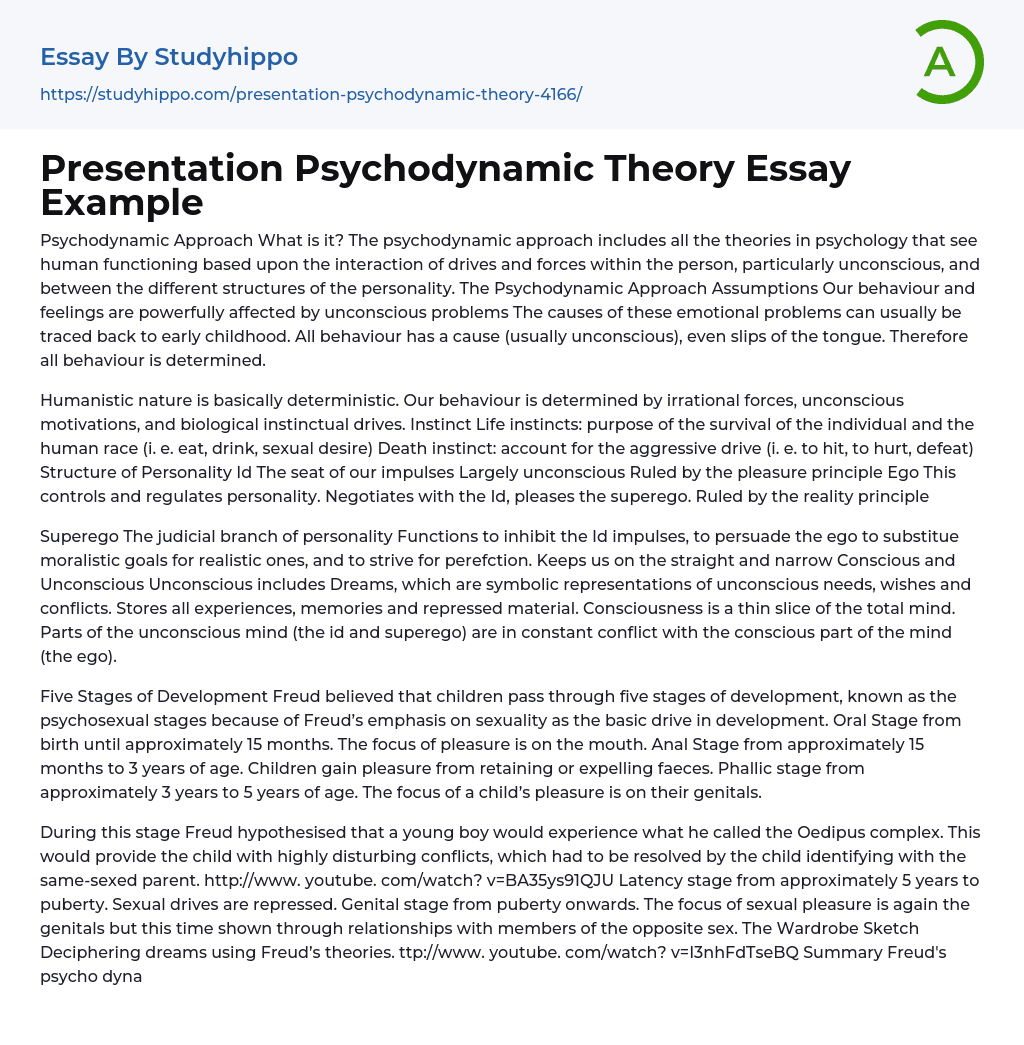Psychodynamic Approach What is it? The psychodynamic approach includes all the theories in psychology that see human functioning based upon the interaction of drives and forces within the person, particularly unconscious, and between the different structures of the personality. The Psychodynamic Approach Assumptions Our behaviour and feelings are powerfully affected by unconscious problems The causes of these emotional problems can usually be traced back to early childhood. All behaviour has a cause (usually unconscious), even slips of the tongue. Therefore all behaviour is determined.
Humanistic nature is basically deterministic. Our behaviour is determined by irrational forces, unconscious motivations, and biological instinctual drives. Instinct Life instincts: purpose of the survival of the individual and the human race (i. e. eat, drink, sexual desire) Death instinct: account for the aggressive drive (i. e. to hit, to hurt, de
...feat) Structure of Personality Id The seat of our impulses Largely unconscious Ruled by the pleasure principle Ego This controls and regulates personality. Negotiates with the Id, pleases the superego. Ruled by the reality principle
Superego The judicial branch of personality Functions to inhibit the Id impulses, to persuade the ego to substitue moralistic goals for realistic ones, and to strive for perefction. Keeps us on the straight and narrow Conscious and Unconscious Unconscious includes Dreams, which are symbolic representations of unconscious needs, wishes and conflicts. Stores all experiences, memories and repressed material. Consciousness is a thin slice of the total mind. Parts of the unconscious mind (the id and superego) are in constant conflict with the conscious part of the mind (the ego).
Five Stages of Development Freud believed that children pass through five stages of development, known as the psychosexual stages
because of Freud’s emphasis on sexuality as the basic drive in development. Oral Stage from birth until approximately 15 months. The focus of pleasure is on the mouth. Anal Stage from approximately 15 months to 3 years of age. Children gain pleasure from retaining or expelling faeces. Phallic stage from approximately 3 years to 5 years of age. The focus of a child’s pleasure is on their genitals.
During this stage Freud hypothesised that a young boy would experience what he called the Oedipus complex. This would provide the child with highly disturbing conflicts, which had to be resolved by the child identifying with the same-sexed parent. http://www. youtube. com/watch? v=BA35ys91QJU Latency stage from approximately 5 years to puberty. Sexual drives are repressed. Genital stage from puberty onwards. The focus of sexual pleasure is again the genitals but this time shown through relationships with members of the opposite sex. The Wardrobe Sketch Deciphering dreams using Freud’s theories. ttp://www. youtube. com/watch? v=I3nhFdTseBQ Summary Freud's psycho dynamic model may seem opaque to us today because he explained it in terms of the technology metaphor of his day. It is as if a scientist today used a current technology such as computers as a metaphor for things that we cannot explain easily. However, Sigmund Freud, although criticized, is a highly respected pioneer of psychology. Freud's theory of the unconscious assumes a private, personal mind; a mind populated with wishes, desires, and needs that have a biological, intra-psychological origin and follow a mechanical law.
- Abnormal Psychology essays
- Abraham Maslow essays
- Attachment Theory essays
- Authority essays
- Behaviorism essays
- Classical Conditioning essays
- Cognitive Psychology essays
- Counseling essays
- Developmental Psychology essays
- Educational Psychology essays
- Erik Erikson essays
- Family Therapy essays
- Jean Piaget essays
- Maslow's Hierarchy Of Needs essays
- Mental Health essays
- Operant Conditioning essays
- Personality Psychology essays
- Positive Psychology essays
- Psychoanalysis essays
- Psychotherapy essays
- Sigmund Freud essays
- Social Psychology essays
- Stanford Prison Experiment essays
- Supersize Me essays
- Experiment essays
- Explorer essays
- Hypothesis essays
- Observation essays
- Qualitative Research essays
- Research Methods essays
- Theory essays




